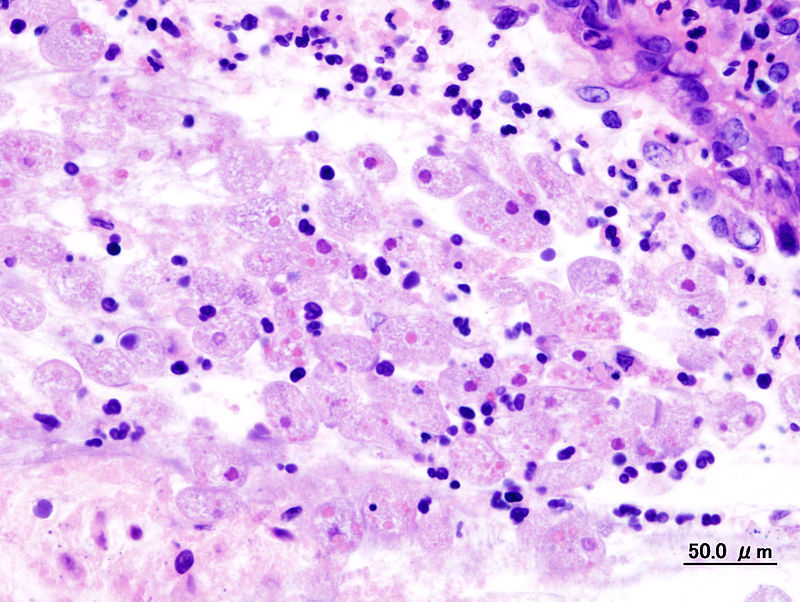Amoebiasis or amoebic dysentery is a waterborne disease that leads to inflammation of gastrointestinal tract in the humans. This infection is caused by drinking water and food contaminated by any amoeba of protozoan parasite of Entamoeba group (mostly Entamoeba histolytica); most of the infections are now believed to be because of E. dispar (more common in certain areas and symptomatic cases may be less common).
It is prevalent all over the world but more common in the developing countries where there’s warmer climate, poor sanitation and socioeconomic status. Amoebiasis is known to affect nearly 500 million people and results in about 100,000 deaths worldwide every year.
Learn about the signs & symptoms, causes and risk factors, complications, diagnosis, prevention and treatment of amoebiasis.
Causes & Risk Factors

In the asymptomatic infection, the Entamoeba histolytica thrives by eating and digesting bacteria and food particles in the gut (part of gastrointestinal tract). It doesn’t necessarily come in contact with the intestine itself because of the presence of protective layer along the gut. The disease takes place when the amoeba comes into contact with the cells along the intestine.
The same substances are secreted that are used by it for digesting the bacteria including the enzymes which destroy cell membranes and proteins. Such a process can result in penetration and digestion of the human tissues, initially leading to flask-shaped ulcers in intestine. Entamoeba histolytica eats up the destroyed cells by phagocytosis and appears with RBCs when looked at stool samples.
The cysts of entamoeba can survive for near about 45 minutes in fingernails and a month in soil. The invasion of the intestinal lining can lead to bloody diarrhea. If the parasite reaches the bloodstream, it can spread throughout body and mostly ends up in liver (causing amoebic liver abscesses).
The amoebic cysts are infective for many days in water, sewage, soil and faeces in presence of low temperature and moisture. Its transmission may occur through faecal-oral route (directly or indirectly), vectors (cockroaches, rodents and flies).
Using night soil for agricultural purposes can be a risk factor for spreading of the disease. The epidemic or outbreaks mostly have an association with sewage into water supply.
Signs & Symptoms

Amoebiasis can have no, mild or severe symptoms. In majority cases, the disease is asymptomatic. It has the potential of making the infected individual seriously ill, leading to death. The onset time of asymptomatic infection may vary greatly and it may persist for more than a year.
The infection can last for several years in some cases. When the symptoms are present, they are mostly due to infection caused by Entamoeba histolytica. The common symptoms include mild diarrhea, abdominal pain or severe diarrhea with blood and mucus. The symptoms can take few days to few weeks to develop but it usually takes 2-4 weeks.
In acute amoebiasis, diarrhea or dysentery with frequent, small and often bloody stools may occur. The chronic amoebiasis can cause gastrointestinal symptoms such as fatigue, weight loss and occasional fever.
Diagnosis
It is crucial to distinguish the entamoeba histolytica from other intestinal protozoa. This diagnosis is typically done by examining stool of the infected person with microscopic identification of cysts and trophozoites but this may not eliminate other similar types. The differentiation occurs on the basis of morphologic characteristics of cysts and trophozoites. Also, E. histolytica trophozoites can also be identified aspirates or biopsy samples that are obtained at the time of surgery or colonoscopy.
The antibody tests including enzyme immunoassay (EIA) and indirect hemagglutination (IHA) are done to look for certain antibodies in the blood but the tests may remain positive following the treatment. If the antibodies can’t be diagnosed in the patients, second specimen should be taken a week later. The antibodies related to E. histolytica may persist for several years, so the presence of antibodies doesn’t necessarily indicate acute or current infection.
Antigen detection may also be useful in detection of parasites and to differentiate between pathogenic and nonpathogenic infections.
Complications
The complications of amoebiasis include colon inflammation with tissue death or perforation. This may result in peritonitis. The affected people may even develop anemia because of blood loss.
The extra-intestinal amoebiasis can take place if the parasite spreads to other organs. The most common organ is liver where amoebic liver abscess is caused. It may be accompanied by fever and abdominal pain.
The other organs that can be involved include cardiac, renal, cerebral, genitourinary, pleuropulmonary, cutaneous and peritoneal sites.
Prevention & Treatment

The amoebiasis can be prevented by improved sanitation, water supply, food safety, health education and socioeconomic development. This includes separating water and food from fecal matter. This infection does not have any vaccine.
Depending on the location of infection, two treatment options exist. Amoebiasis in the tissues is treated using any of these: metronidazole, tinidazole, nitazoxanide, dehydroemetine or chloroquine. Whereas, the luminal infection is treated using diloxanide furoate or iodoquinoline.
The effective treatment of the disease may require a combination of medications. The infections without symptoms don’t require any treatment. But as it is an infectious disease, the infected people can spread the parasite to others and treatment can be considered.
Image Source:
1. wikimedia
2. thehealthsite
3. freshid

